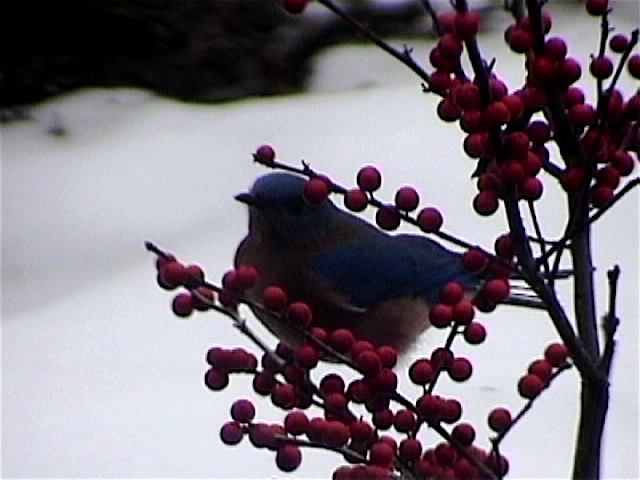Activities
![]() Charting eggs ele
Charting eggs ele
![]() All about Birds ele/ms
All about Birds ele/ms
![]() Frayer Model Birds - doc. | pdf
Frayer Model Birds - doc. | pdf
![]() Collecting data ele/ms
Collecting data ele/ms
![]() Nest Box Log ele/ms/hs
Nest Box Log ele/ms/hs
![]() Life Cycles ele/ms
Life Cycles ele/ms
![]() Variables ele/ms/hs
Variables ele/ms/hs
![]() Feather Facts ms/hs
Feather Facts ms/hs
![]() Scientific Thinking ele/ms/hs
Scientific Thinking ele/ms/hs
![]() Systems & Controls ms/hs
Systems & Controls ms/hs
![]() Science Journal Entry ms/hs
Science Journal Entry ms/hs
![]() Make Puzzle ele/ms/hs
Make Puzzle ele/ms/hs
![]() Ecology Vocabulary ms/hs
Ecology Vocabulary ms/hs
![]() Classification ms/hs
Classification ms/hs
Other Nestbox residents:
Bluebirds Winter Photo
One snowy Christmas morning, I had a pleasant surprise.
I planted winterberry bushes just outside my living room windows. Their bright red berries are a cheerful splash of color in winter, when much of the garden is bare.
It was snowing hard. The ground was covered with a 12 centimeter thick blanket of snow. The red berries on the bushes had attracted a small flock of cedar waxwings and bluebirds.
Female bluebird with a winterberry
Male Bluebird on a Winterberry bush
For two days, the small flock feasted on the berries. Bluebirds and cedar waxwings have returned each winter. In a day or so, the berry covered bushes are bare. We have observed that the birds do not eat the berries until mid to late winter. I wonder why? The bushes have also attracted early returning robins and starlings.*

I noticed that all the birds ignored the berries that fell to the ground. One cold, late spring day, I gathered the berries and placed them in a small feeder. I hung the feeder over the bare bushes. The berries were gone the next morning. Unfortunately, I missed seeing the birds take them.
*I shoo away the European Starlings whenever I see them. They are not native birds. They compete with bluebirds for food and nesting places.
![]() Bird Species List for FeederWatch - make one
Bird Species List for FeederWatch - make one
![]() Biodiversity Exploration Investigation
Biodiversity Exploration Investigation
![]() BirdSleuth: Investigating Evidence - free materials from Cornell University
BirdSleuth: Investigating Evidence - free materials from Cornell University
©2002 Cindy O'Hora All Rights Reserved, Updated 10/2008, Posted May 2002
This work is licensed under a Creative Commons Attribution-NonCommercial 2.5 License.
Aligned with the Pennsylvania Academic Standards for Science & Technology, Reading, Writing, Ecology & Environment, Mathematics